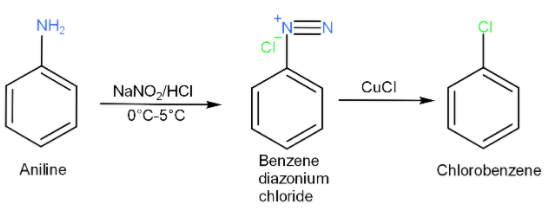
Chlorobenzene can be prepared by reacting aniline with:
(A) Hydrochloric acid (HCl)
(B) Cuprous chloride $\left( C{{u}_{2}}C{{l}_{2}} \right)$
(C) Chlorine in the presence of anhydrous aluminium chloride
(D) Nitrous acid followed by heating with cuprous chloride (CuCl)
Answer
133.2k+ views
Hint: Start by drawing the structure of the reactant. Think what kind of reactions aniline undergoes with the given reagents in the options. The product formed should not contain any other substituent on the ring except chlorine.
Complete step by step solution:
-Aniline is an aromatic amine. It is a base.
-Let’s have a look at the question. We need to prepare chlorobenzene from aniline. That means the amine group needs to be replaced by a chlorine group.
-We have studies that amine group can only be replaced after it has been converted to diazonium salt form, which is unstable. Direct halogenation of aniline will give rise to halogen derivatives of aniline.
-If HCl is added to aniline, then aniline being a base will abstract the proton and form anilinium chloride salt.
-When aniline is treated with nitrous acid, which is produced in situ by sodium nitrite and hydrochloric acid, at low temperature $\left( 0{}^\circ C-5{}^\circ C \right)$, then aniline is converted to a benzene diazonium salt. This reaction is known as diazotization.

-When a freshly prepared solution of benzene diazonium salt is treated with cuprous chloride (CuCl), it gives chlorobenzene. This reaction is known as Sandmeyer’s reaction.
-Therefore, chlorobenzene can be prepared by reacting aniline with nitrous acid followed by heating with cuprous chloride (CuCl).
Therefore, the correct option is (D).
Note: Chlorobenzene can also be prepared by treating benzene diazonium salt with copper powder and hydrochloric acid. This reaction is known as Gattermann reaction and has a better yield than Sandmeyer reaction. Remember in aromatic compounds electrophilic substitution reactions occur readily and therefore, direct halogenation will yield halo-substituted compounds.
Complete step by step solution:
-Aniline is an aromatic amine. It is a base.
-Let’s have a look at the question. We need to prepare chlorobenzene from aniline. That means the amine group needs to be replaced by a chlorine group.
-We have studies that amine group can only be replaced after it has been converted to diazonium salt form, which is unstable. Direct halogenation of aniline will give rise to halogen derivatives of aniline.
-If HCl is added to aniline, then aniline being a base will abstract the proton and form anilinium chloride salt.
-When aniline is treated with nitrous acid, which is produced in situ by sodium nitrite and hydrochloric acid, at low temperature $\left( 0{}^\circ C-5{}^\circ C \right)$, then aniline is converted to a benzene diazonium salt. This reaction is known as diazotization.

-When a freshly prepared solution of benzene diazonium salt is treated with cuprous chloride (CuCl), it gives chlorobenzene. This reaction is known as Sandmeyer’s reaction.
-Therefore, chlorobenzene can be prepared by reacting aniline with nitrous acid followed by heating with cuprous chloride (CuCl).
Therefore, the correct option is (D).
Note: Chlorobenzene can also be prepared by treating benzene diazonium salt with copper powder and hydrochloric acid. This reaction is known as Gattermann reaction and has a better yield than Sandmeyer reaction. Remember in aromatic compounds electrophilic substitution reactions occur readily and therefore, direct halogenation will yield halo-substituted compounds.
Recently Updated Pages
Sign up for JEE Main 2025 Live Classes - Vedantu

JEE Main Books 2023-24: Best JEE Main Books for Physics, Chemistry and Maths

JEE Main 2023 April 13 Shift 1 Question Paper with Answer Key

JEE Main 2023 April 11 Shift 2 Question Paper with Answer Key

JEE Main 2023 April 10 Shift 2 Question Paper with Answer Key

JEE Main 2023 (April 6th Shift 2) Chemistry Question Paper with Answer Key

Trending doubts
JEE Main 2025: Conversion of Galvanometer Into Ammeter And Voltmeter in Physics

Classification of Drugs

Chlorobenzene can be prepared by reacting aniline with class 12 chemistry JEE_Main

Current Loop as Magnetic Dipole and Its Derivation for JEE

Inertial and Non-Inertial Frame of Reference - JEE Important Topic

JEE Main B.Arch Cut Off Percentile 2025

Other Pages
NCERT Solutions for Class 12 Chemistry In Hindi Chapter 10 Haloalkanes and Haloarenes In Hindi Mediem

JEE Advanced 2024 Syllabus Weightage

Conversion of phenol to salicylic acid and to salicyaldehyde class 12 chemistry JEE_Main

CBSE Date Sheet 2025 Class 12 - Download Timetable PDF for FREE Now

JEE Main 2025 Session 2: Exam Date, Admit Card, Syllabus, & More

CBSE Class 10 Hindi Sample Papers 2024-25




